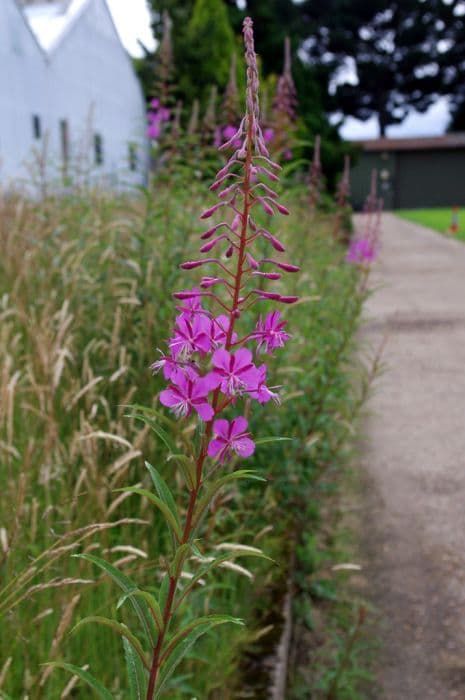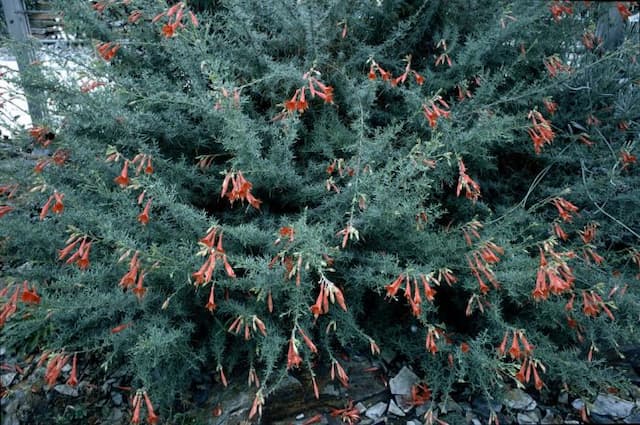Fuchsia Fuchsia 'Sunray' (v)

ABOUT
Fuchsia 'Sunray' is an ornamental plant known for its distinctive two-tone flowers. These blooms dangle elegantly from the plant like decorations and consist of a combination of purple and pink hues. Typically, the outer petals are a lighter shade, often a soft pink, which gracefully curve back, revealing the inner petals that burst with a deep purple or magenta color. These inner petals sometimes resemble a skirt with ruffled edges, encasing the long, protruding stamens that often carry pollen at their tips. The foliage of this cultivar is equally attractive, bearing leaves that have a lush, green color, some varieties sporting a subtle bronze tint or margin. The leaves have a delicate veining pattern, with a soft, velvety texture, and they tend to be elongated with a slight point at the end. Fuchsia 'Sunray' often displays an arching or trailing growth habit, which makes it particularly suitable for hanging baskets or as a spiller plant in mixed containers where its opulent blooms can cascade over the sides gracefully. The overall appearance of the Fuchsia 'Sunray' is one of extravagant beauty, with its abundant flowers offering a long-lasting display that can add a touch of elegance to any garden or patio setting.
About this plant
 Names
NamesFamily
Onagraceae
Synonyms
Lady's Ear Drops
Common names
Fuchsia 'Sunray' (v).
 Toxicity
ToxicityTo humans
Fuchsias, including the Fuchsia 'Sunray', are generally considered non-toxic to humans. Although they are not poisonous, ingesting any part of the plant, especially in large quantities, could potentially cause mild stomach upset due to the unusual plant compounds that the human digestive system is not used to.
To pets
Fuchsias, including the Fuchsia 'Sunray', are typically safe and non-toxic to pets such as cats and dogs. If a pet were to ingest parts of the plant, it is unlikely to cause serious harm or significant symptoms of poisoning. However, as with any non-food plant, ingestion could potentially result in mild gastrointestinal upset, like vomiting or diarrhea, due to the plant's fiber and compounds not typically present in the pet's diet.
 Characteristics
CharacteristicsLife cycle
Perennials
Foliage type
Deciduous
Color of leaves
Variegated
Flower color
Mixed
Height
2 feet (0.61 meters)
Spread
2 feet (0.61 meters)
Plant type
Shrub
Hardiness zones
9
Native area
Central America
Benefits
 General Benefits
General Benefits- Attracts Pollinators: Fuchsia 'Sunray' is known for attracting bees, butterflies, and other beneficial insects, which are important for pollination in the garden.
- Ornamental Value: With its striking and colorful flowers, Fuchsia 'Sunray' adds aesthetic appeal and beauty to gardens, patios, and balconies.
- Versatility: This plant is versatile and can be grown in pots, hanging baskets, or directly in the ground, making it suitable for various gardening spaces.
- Habitat Enrichment: Provides a source of nectar and habitat for pollinators, contributing to the biodiversity in the ecosystem.
- Easy to Grow: Fuchsia 'Sunray' is known to be easy to care for and can thrive with minimal maintenance, making it a good choice for novice gardeners.
- Long Blooming Period: This plant often has an extended blooming period, providing color and interest throughout the growing season.
 Medical Properties
Medical PropertiesThis plant is not used for medical purposes.
 Air-purifying Qualities
Air-purifying QualitiesThis plant is not specifically known for air purifying qualities.
 Other Uses
Other Uses- Crafting Natural Dye: The vibrant colors of Fuchsia flowers can be used to create natural dyes for fabrics, yarns, and papers.
- Edible Decorations: The flowers of Fuchsia can be used as edible decorations for desserts and cocktails, adding a splash of color and a unique aesthetic.
- Photography Subject: Due to its striking appearance, Fuchsia is often used as a subject for botanical photography and art.
- Garden Design: Fuchsia plants are utilized for their drooping flowers in vertical garden designs, such as living walls and hanging baskets.
- Culinary Experiments: Some adventurous cooks use the slightly acidic Fuchsia berries in recipes for jams, jellies, and pies.
- Teaching Tool: Fuchsias can be used in educational settings to teach about plant biology, hybridization, and the care of delicate flowers.
- Insect Attraction: Fuchsia flowers can attract pollinators like hummingbirds and bees to the garden, which is beneficial for biodiversity.
- Companion Planting: Fuchsia may be used in companion planting to complement other plants in the garden, though its companions must be chosen with care to avoid competition for resources.
- Cultural Ceremonies: In some cultures, the Fuchsia plant may play a role in ceremonies or be given as a gift to signify trust and confiding.
- Artistic Inspiration: Artists may use the diverse forms and colors of the Fuchsia as inspiration in paintings, textiles, and other mediums.
Interesting Facts
 Feng Shui
Feng ShuiFuchsia is not used in Feng Shui practice.
 Zodiac Sign Compitability
Zodiac Sign CompitabilityFuchsia is not used in astrology practice.
 Plant Symbolism
Plant Symbolism- Confiding Love: The delicate teardrop shape of Fuchsia flowers symbolizes confiding love, where emotions are shared with a trusted loved one.
- Elegance and Good Taste: Fuchsia's graceful appearance represents sophistication and discernment, suggesting a person of refined tastes.
- Ambivalence: Historically, the Fuchsia flower has been associated with ambivalence due to its pendulous shape, hinting at complexity in emotions or relationships.
- Astuteness: As Fuchsias are somewhat tender and require careful care to thrive, they can denote astuteness in nurturing and understanding delicate situations.
- Overflowing Abundance: The prolific blooming of Fuchsia 'Sunray' plants can symbolize an overflowing abundance of beauty, creativity, or prosperity.
 Water
WaterFuchsia 'Sunray', commonly known as trailing fuchsia, should be watered regularly to keep the soil consistently moist but not soaking wet. Generally, watering once or twice a week is sufficient. Use approximately 16-32 ounces of water per plant each time, depending on the size of the plant and environmental conditions. Increase watering during hot, dry periods and reduce it during cooler, rainy seasons. Avoid waterlogging by making sure the container has adequate drainage.
 Light
LightThe trailing fuchsia thrives in bright, indirect light. It should be placed in a spot where it receives morning sunlight but is protected from the harsh afternoon sun. A north-facing or east-facing window typically offers the ideal lighting conditions for this plant.
 Temperature
TemperatureThe trailing fuchsia prefers moderate temperatures and does best in environments where the temperature ranges between 60°F and 75°F. It should be protected from temperatures below 35°F to prevent cold damage and should not be exposed to extreme heat over 85°F as this could cause stress to the plant.
 Pruning
PruningPruning is essential for trailing fuchsias to promote bushier growth and enhance flower production. Prune in the late winter or early spring before new growth begins by cutting back the stems by one-third to one-half. Remove dead or weak branches to maintain the plant's shape and encourage healthy growth. Trailing fuchsias may also be pinched throughout the growing season to encourage branching.
 Cleaning
CleaningAs needed
 Soil
SoilFuchsia 'Sunray', commonly known as hardy fuchsia, requires a moist, well-draining soil mix rich in organic matter such as peat or well-rotted compost. A good mixture might consist of one part loam, one part peat moss, and one part perlite to ensure good drainage. The soil pH should be slightly acidic to neutral, preferably between 6 and 7.
 Repotting
RepottingHardy fuchsias should generally be repotted every 2-3 years to provide fresh soil and encourage healthy growth. If the plant has outgrown its current pot or the soil has compacted, it may need repotting more often.
 Humidity & Misting
Humidity & MistingFuchsia 'Sunray' requires moderate to high humidity levels to thrive. Aim for humidity levels around 60-70% for optimal growth, avoiding conditions that are too dry to ensure the plant stays healthy and vibrant.
 Suitable locations
Suitable locationsIndoor
Place in bright, indirect light and maintain high humidity.
Outdoor
Protect from wind, part shade, and keep moist in summer.
 Life cycle
Life cycleFuchsia 'Sunray' (variety), commonly known simply as Fuchsia, begins its life cycle when seeds are sown in a moist, well-draining growing medium, typically during spring. The seeds germinate, and seedlings emerge within a few weeks, given the right temperature and conditions. The young plants grow rapidly, developing a bushy habit with stems that can be pinched back to encourage branching and fuller growth. As the Fuchsia matures, it enters the flowering stage, producing distinctive pendant-like blossoms, which can be in a range of colors from pinks to purples, throughout the summer and into early fall. After flowering, if conditions are favorable, the plant will produce small fruits containing seeds, but often they are grown from cuttings for propagation. The Fuchsia is perennial in milder climates, dying back to the ground in winter and re-sprouting in spring, or it can be overwintered indoors in colder regions.
 Propogation
PropogationPropogation time
Spring-Early Summer
The Fuchsia 'Sunray', commonly known as Fuchsia, is best propagated during the growing season, which generally spans from spring through summer. The most popular method for propagating Fuchsias is through softwood cuttings, which involves taking a young, yet slightly mature stem from the parent plant. These cuttings, typically 2 to 4 inches (approximately 5 to 10 centimeters) long, should include a few leaves and be cut just below a leaf node. The lower leaves are then removed, and the cutting is dipped in rooting hormone to encourage root growth. It's then planted in a mix of peat and perlite or a similar well-draining medium, kept moist, and placed in a warm area with indirect light. To maintain a high humidity level that cuttings prefer, covering them with a plastic bag or placing them in a propagator is often advised. Roots usually develop within 3 to 4 weeks, after which the new Fuchsia plants can be gradually acclimatized to less humid conditions and eventually pot on as they grow.









